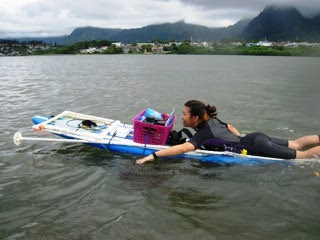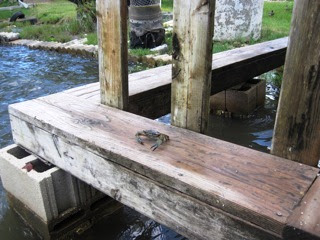My teammates for the day were Becky and Sam (and Martin... kind of). We started with the plot farthest in the pond and worked our way out. All the while dreading plot 65 or "the deep spot". Rotating turns recording, coring and doing algal cover we made our way through the first three plots.
Then came plot 65. As Becky and Sam finished up plot 86, I took the GPS and map to attempt finding plot 65. I walked along the makeshift wall along the puka and actually got really close coordinates. While waiting, I saw a puffer fish and some other unknown fish (which was pretty big). Sam and Becky made their way over and when Becky started swimming I knew it was pretty deep. Thank goodness it was just that spot and the actual plot was only a little deeper than most other plots.
Thus ended the day! We got back to shore and chilled while the water samples were being filtered.
 Paddling instead of walking. (Seemed like a good idea but it was just as fast as walking and it made my arms hurt.)
Paddling instead of walking. (Seemed like a good idea but it was just as fast as walking and it made my arms hurt.)
This week we also had a Saturday workday! It was supposed to be and Aunty Donnie day but it didn't work out. (I hope her kupuna gets well soon!) When we arrived (~9am), the tide was pretty low so I checked the tide calendar. Each day has two low tides and two high tides. The lowest of the low tides or as I call it low low tide was ~8am and the the highest of the high tides (high high tide) would be ~3pm. At first I thought this to be bad but as it turns out it was a very wondrous thing! Again we split into two teams each taking four plots each (the last eight plots!). This time I was with Sam and Aukai. Saturday was hot and sunny (got sunburned) but fun. I admit that our group was a little slow because I got distracted by taking macro pictures with the camera.
On the way out of the pond, the tide was rising which led to the makeshift wall becoming a sort of waterfall/standing wave. It was nawts (excuse my spelling). One of the coolest things I have ever seen. I didn't think that the incoming water would produce such a strong current. I could walk straight because it was so strong.
We also caught two crabs that were in the boat and released them back into the fishpond. For some reason when we released the big crab I kept imagining that one seen in Finding Nemo when the crab gets away from the seagull. Here's the link for the clip if you don't know what I'm talking about: http://www.youtube.com/watch?v=p-3e0EkvIEM&feature=related
Even though Saturday was an unexpected workday, it was still enjoyable thanks to the awesome people I get the pleasure to work with.

















